I haven’t played the sequel to my favorite Final Fantasy game, Final Fantasy Tactics, in ages. And even when I played it before, back in the Gameboy Advance days, I never got that far into it — the tiny screen just didn’t work for JRPGs for me. So I spent a lot of money getting a Nintendo DS — the one with the GBA slot — and a complete copy of the game, and decided to give it another shot.
I didn’t know what I was getting into.
Final Fantasy Tactics Advance, the game, can be broadly split into three parts. The first is the main plot of the game — you play the “new kid” who just moved to St. Ivalice, a small town in what we would recognize as the real world. Your friend, Mewt, is planning to buy an old fantasy book at the used book store, one with pictures of knights and dragons in it, and you invite Mewt and Ritz, another friend, over to your house to take a look at it and let everyone meet your crippled brother, Doned.
Later that night, the world changes, and you and your friends are now in a strange land called Ivalice, and all the familiar landmarks are now fantasy. Mewt has become the prince of the land, his widowed father, Cid, has become the Lord High Judge of the land, and his mother has come back to life and is now the queen. Mewt’s teddy bear is now his advisor, Babus, and more than anything else, he does not want to go back to the real world.
Doned is here, and can walk. You and Ritz have become the leaders of rival clans. But you know this is just a dream, and all of you must wake up and face the real world together…
That’s the first part.
The last part is an arc focusing on the Judges, which has Judge Cid join the party and seek out corruption among the Judges that adjudicate the fights in Ivalice. This plotline leads into the plots of Final Fantasy XII, as well the the sequel to FFTA, Final Fantasy Tactics A2: Grimoire of the Rift, which was released for the Nintendo DS.
In between is where I am now.
The third part of the game opens up with the player has completed all 300 main missions in the game. Missions come in a few different varieties — some are ones you send one of your characters out to run, automatically — like the dispatch missions in FFT. Others are plot related. Some deal with fighting other clans for dominance. Others are realm-wide contests of tactics, magic, martial abilities, and specific terrains. Most of them require items given by other missions, and give items needed for the next mission in turn. Most only are available during a given season, or in a given town, or once your clan has reached a high enough level in a certain clan skill, or combinations of all the above.
Fact is, for most of those three hundred missions, you won’t know where to get the requirements, or what to do with the rewards, until you happen upon the correct combination of elements to get a mission that you can complete. Getting one step closer to the true end of the game.
So aside from that, Mrs. Lincoln, how did you like the play?
attrib. to Aristotle
So anyway, it’s a little frustrating. The game is in some sort of pause, and I am just doing random clan battles to move along missions that require battles or defeated enemies to progress. Nothing ever dies, in FFTA. It’s a kid’s dream, after all. The Judges that set the conditions for each battle — and will fine you or imprison you if you break them — make sure that all injuries are healed, all the dead restored to life, after each battle. So nobody gets all that upset when they lose.
The exception are the lawless regions called “Jagds”. There are no Judges, and without judges, death is permanent. If you leave one of those regions with dead left on the field, they are gone forever. Some missions are only available if you lost your moogle friend Montblanc in this way. If you die in a Jagd, it’s game over.
A better way to take a step into the lawless side are with “anti-laws”, laws that let you break other laws. After a certain point in the story, these become available, and a little after that, you begin to encounter anti-anti-law laws, that forbid the use of anti-laws, because the Judges are learning and adapting.
The “Dmg2: Animal” law would make this particular battle nearly impossible, as it forbids damaging monsters, and there are monsters on the field. I believe they can only be killed by removal at this point, but I always anti-law myself out of these things. The “Allmighty” anti-law removes ALL laws, though I don’t believe it works vs anti-anti-law laws. As well as removing laws, you can also add new laws. For instance, if you want to make sure your Viera sniper can work her magic without interruption, you can suggest a new law that forbids damage to Viera. If the enemy doesn’t have any Viera on the field, you’re pretty much home free.
But then, enemy bosses have paid off the judges, and judges won’t imprison them for breaking laws, so if you have a boss on the field, they will happily clear your Viera sniper away. Without this rule, shutting down bosses would be easy.
FFTA really leans into the law mechanic, adding another layer of strategy to an already difficult game. The laws make it difficult to have a really killer core group, as their abilities can be arbitrarily shut down at any point. Additionally, missions have the best chance of succeeding when you send your best units — unlike Tactics, where missions were the exclusive task of units you didn’t care to use much. As I’ve worked through the levels, my core group has changed and adapted, and I have about ten units I use.
- Corwin (protagonist) — Hunter/Archer/Ninja (named after my grandson)
- Montblanc — Gunner/Animist/Black Mage
- Nansen — Sage/White Mage/Black Mage
- Smyth — Blue Mage/Black Mage/Illusionist
- Toksa — Sniper/Sharpshooter/Assassin/Red Mage
- Meiyou — Gadgeteer/Animist/Gunner
- Nonse — Paladin/Fighter/Soldier
- Ritz — Fencer/White Mage
- Sharrah — Archer/Sharpshooter
…plus a few more I bring in when too many of those are on missions, or whose jobs are blocked by laws. Using anti-laws is expensive, and most of the time, it’s better to just go along with the flow and save anti-laws for when you really need them.
So I’m still playing Final Fantasy Tactics Advance, though I soon moved from the Nintendo DS to an emulator with it because, apparently, my eyes haven’t improved in the decades since it came out. I do want to see the Judge story.
Where would this fall, compared to other Final Fantasy Tactics-adjacent games?
- Final Fantasy Tactics (PS)
- Ogre Battle March of the Black Queen (SNES)
- Ogre Battle Let Us Cling Together (PS)
- Final Fantasy Tactics Advance (GBA)
- Final Fantasy XII (PS2)
- Vandal Hearts (PS2)
In no particular order, these are the tactics games by or under the direction of the original Final Fantasy Tactics designer. There are others, but these are the ones I own. And yes, the Ogre Battle games are named after Queen songs.
Final Fantasy Tactics has a great story, but it is easy to make an unstoppable team, and autobattle allows the player to easily level up to one-shot kill everything.
March of the Black Queen is a real time RPG which is really entirely unlike the others, with defending capture points leading into turn-based tactical combat. It’s a pretty special game. I haven’t been able to track down the sequel that keeps this same style of gameplay.
Let Us Cling Together’s story is fairly standard. I did like the interaction between the jobs there. This one is similar enough to FFT that I would absolutely recommend an FFT fan to immediately play LUCT.
Final Fantasy XII isn’t a turn-based strategy game, but it does share a setting with FFT/FFTA and introduces the Gambit system and includes several characters from FFTA and FFTA2.
I have, but haven’t yet played, Vandal Hearts, so I can’t place that.
To be honest, the only one of the games on this list that I have played that I would immediately want to play again is Ogre Battle: March of the Black Queen. Making squadrons of units tuned to defend, capture, or snipe at other enemy squadrons, and then drop into tactical battle, is just really a lot of fun.
Final Fantasy Tactics is the game that sparked my love for the genre, and I have played it many, many times. So, let’s place Final Fantasy Tactics Advance third on the list, behind FFT and MotBQ.
Worth playing.
I have a bunch of videos of my playthrough for FFTA on my Twitch channel. Don’t worry, I don’t talk over my videos anymore.

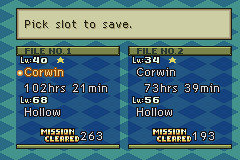
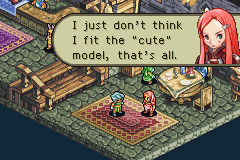
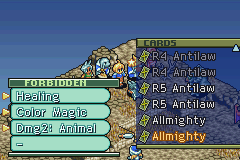
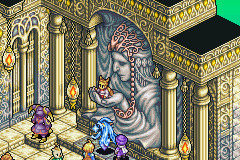
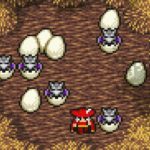
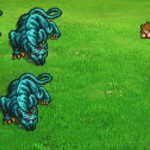
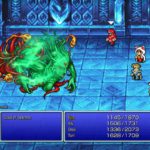
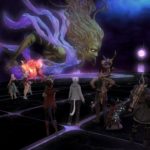
I have that and a game boy color to play it sitting in a box somewhere. It was an absolutely astounding portable game for the day. The GBA was the first portable system where is seemed like game designers were no longer really held back by the hardware specs they were working with at all. I have FFTA and two Metroidvania games on it. However, of everything I’ve tried on it the one I enjoyed the most was Pokemon Red.
More on topic, I have tried to get into FFTA several times but I have trouble getting immersed in it. I would guess 20 missions in is probably as far as I’ve ever made it. I am not sure if it’s the somewhat arbitrary rules system, the fact that I am never quite sure what I am supposed to be working towards, or just that I need to play it on a larger screen.
I remember, the first time playing it, that I really didn’t like how the Judges just made things harder for no reason. I wanted more FFT, but FFTA goes its own way.
I have no idea what happened to my GBA and GBA games from back in the day. Probably gave it to one of my kids. I have Pokemon Rescue Team Blue for the DS, so that’s the game I am playing on the console itself 😉